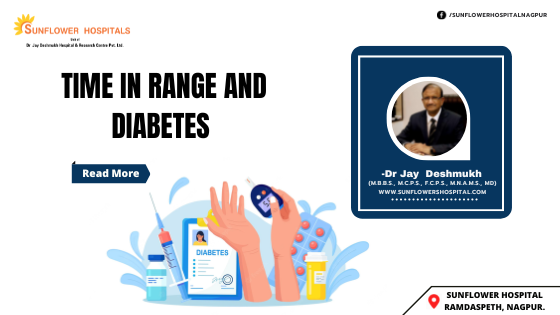What should be a good time spent in Time In Range?
Blood glucose varies in each diabetic. The hours spent in range and out of range vary. A typical tar-get range is from 70 to 180 mg /dL. In most people with type 1 or 2 diabetes, a TIR above 70 % is recommended. That is about 17 hours per day the blood glucose should be between 70 to 180 mg per day.
What are the other targets in Time in Range that is TIR?
One should aim to spend less than 4% that is 58 minutes below 70 mg, less than 1% that is 14 minutes below 54 mg, and less than 25% that is 6 hours above 180 mg%. Only 5% of the dine-in 24 hours that is 1 hour and 12 minutes should the blood glucose be above 250 mg. TIR targets can be higher or lower for older or high-risk individuals and for those younger than age 25 years.
If a person has a TIR of 50%, then what does it mean?
This would indicate that your glucose levels were within the target range for an average of 12 hours on any given day The target range is usually between 70 mg to 180 mg / dL.
How does TIR differ from HBAIC?
‘FIR gives you many advantages. The HbAlc only represents the average glucose over the last 2 to 3 months as a single snapshot. That means lower HbAlc does not necessarily mean that your blood glucose levels are better. You can still achieve a good HbAlc rate. Lesser the time spent in TIR more the complications. Lower the TIR greater the glucose variability and more the damage to arteries supplying blood to the heart, brain, kidneys, and retina.
How do I measure time in the target range?
This is done by the CGM system. This measures blood glucose every 5 minutes for 14 days. By using a standard glucometer, you may have to prick every 5 minutes for 14 Times in range or TIR is the amount of time spent by a diabetic with their blood glucose levels in a recommended target range and is represented as a percentage. More diabetics use CGM, that is Continuous Glucose Monitors to help achieve TIR.CGM is a step beyond simple Blood Glucose Fasting and Post meals and is even different from than HbAlc measurement. CGM is the future of appropriate diabetes management. in spite of many hypoglycemias and hyperglycemia episodes. A higher TIR automatically means a more stable glucose control with less time in hypo and hyperglycemia.
What is the relationship between ‘FIR and the risk of complications?
As per recent studies, the more the time spent in ‘FIR less the complications. HbAlc is influenced by various external factors, that as the Red blood cell survival rate and many others. Higher the time spent in TIR lower the complication days, which obviously is not possible. Most CGM devices automatically determine your blood glucose without giving you pricks. This is done by a sensor.
How does CGM work?
A small sensor is placed on your arm or belly. An applicator makes this easy. The sensor reads your blood glucose reading every 5 minutes for 7 days or 14 days. A transmitter is used to wirelessly send the glucose data from the sensor to a device where you can view it. The transmitter is reusable and attached to a new sensor. Glucose data from the sensor is sent to a handheld device called a receiver which is quite similar to our cell phone. The data can also be received by an app. on your cell phone or to an insulin pump. You can download CGM data on your computer at any time. Are Continuous Blood Glucose Monitoring devices easy to use? You need some time to understand the device. You need to know how to insert the sensor properly. For certain CGM devices, you need to calibrate with finger-prick blood glucose readings. You need to set the device alarm. Transfer data to your cell phone or computer You need to respond to and make necessary changes in your treatment plan.
Is a continuous glucose monitoring system the same as an insulin pump?
They are not the same. They have very different functions. CGM devices measure your glucose levels automatically every few minutes. Insulin pumps deliver a steady flow of insulin based on the settings you have made. But they are similar in some ways. Both are automated, worn directly on the body, customizable, and convenient. Both help you to better manage your diabetes. Certainly, a CGM device helps you to monitor your blood glucose in a better way. It cannot be a substitute for a finger prick assessment of blood glucose. This is a new technology and embraces a new concept in diabetes management. The concept is Time In Range.

